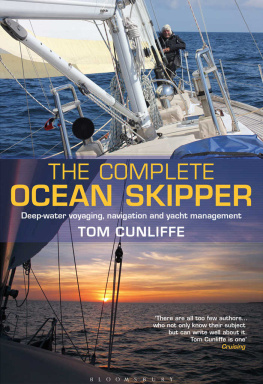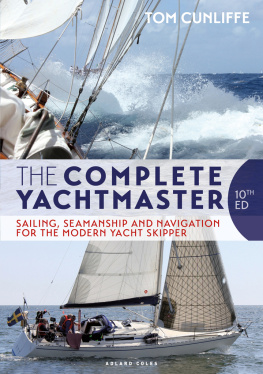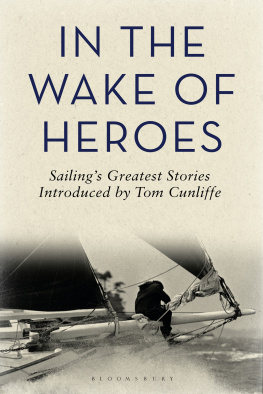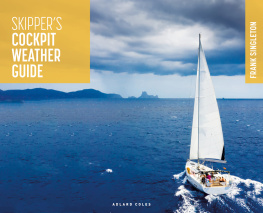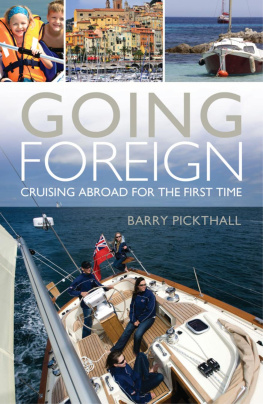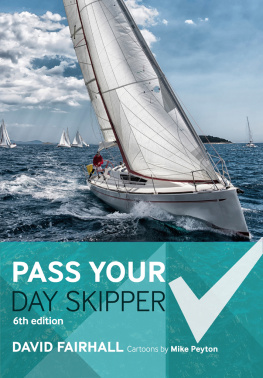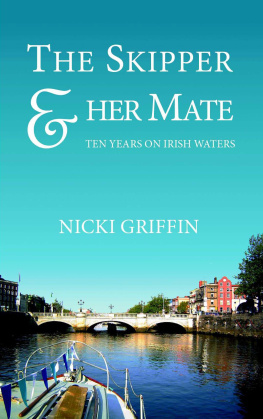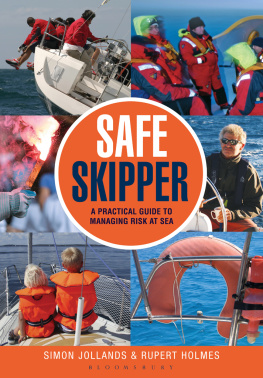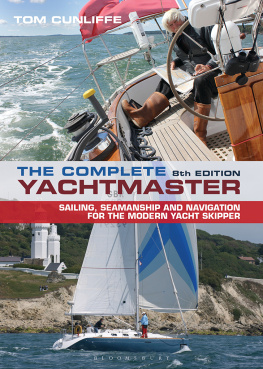
CONTENTS

INTRODUCTION
The Ocean Skipper

The authors first ocean cruiser, the Colin Archer pilot cutter Saari seen here hauled out on Frenchys slip in Grenada in 1976. The tall, thin character is the author in another life.
My first real deep-sea experience came in the form of a 90-ton trading ketch, bought out of commerce in the Baltic in 1968. She was fully crewed but a long way from her first blush of youth. We made the masts and spars ourselves. Five years later I sailed from England bound for Brazil with just my wife in our ancient 32ft Norwegian pilot cutter designed by the great Colin Archer, a vessel whose engine failed more often than it ran. So wretched was this machine that for over a year of intense cruising we managed without power of any sort. Neither of these boats had any electronics whatsoever. Navigation was by the sun, planets and stars a situation that continued into the early 1990s in subsequent boats. Steering on our boat was by windvane. The ketch didnt even have electric lighting and I spent many an evening trimming and filling the sidelights, then hanging them in the rigging. It really does seem like a different world.
Since then, although I have favoured traditional boats, my approach to seafaring has moved with the times. After the Colin Archer came family and a 51ft Bristol Channel Pilot Cutter built in 1911. In her we voyaged to the Arctic, the Caribbean and the US and were, I understand, only the third Western yacht to visit Soviet Russia after the 1917 revolution. With this fine vessel, I cut my teeth on GPS navigation. She was followed by Westernman, a 41ft replica pilot cutter designed by my good friend Nigel Irens, better known for his record-breaking multihulls. With Westernman, chart plotters grew up and I embraced long-range radio reception, giving me more idea of the weather than I could gain from looking at the sky and the sea and assessing the movements of the barometer. Westernman was built in eastern North America and her first trip was a romp home across the North Atlantic from Cape Cod to the Bishop Rock.
During all this time, I had been plying my trade as a skipper for hire. This led to a number of interesting voyages, including a transat with an unstayed carbon Aerorig, which impressed me mightily. My present boat is a Mason 44 cutter, heavily built in GRP with a long keel, a powerful diesel, big tanks, metal spars and stainless rigging. Although not what youd call a high-speed cruising sled, she is a thoroughly modern yacht equipped with a generator, a freezer, cabin heating, a fine autopilot, two computers, internet access and all the navigational electronics available.
To have lived through such a dramatic period of development has placed my generation of sailors in a privileged position, with what I believe to be a sound perspective on ocean sailing today. I, for one, have wholeheartedly embraced the new, but have sufficient experience of what went before to understand where some of the latest ideas fall short when tested in the courtroom of reality. I love my cold beer, my warm, dry feet, my bright lights and the complete . Today I can carry on my work as a journalist wherever I may be by virtue of modern communications. Rather than waiting months to receive mail at a poste restante, I can be in contact with my family and friends knowing theyll receive my missives the same day, unless Im lurking somewhere around the Date Line, in which case they might even get it before I send it. The ability to communicate easily and the general proliferation of yachts on the oceans have transformed medical planning for the far-flung sailor. The list goes on.
The result of all this progress is that theres a lot more to ocean sailing than ever there was back in the 1970s. Then, it was a matter of applying common sense to issues of victualling for the ship and her people, learning astro navigation, finding out about tropical revolving storms and how to manage a yacht caught out in one. Ocean passage planning hasnt changed much, except that we are now far better served with publications and data culled from thousands of yachts whove been actually doing it. Everything else has undergone a revolution and much of this book is about the results of that revolution, understanding them and considering how we can best use them to our advantage.
I have included a chapter on basic astro navigation and I do this without apology. It isnt much of an ocean skipper who cant deliver a position from a sun-run-sun celestial fix. Its a matter of personal satisfaction for a real sailor, not just backup in case someone sits on the GPS transmitters. I could have written this in a sort of shorthand that would allow readers to work up a position while understanding little of what they were doing. I have not been tempted by that approach. Nor have I become dewy-eyed about clever computer programs that do the job for you. Theres no patronising here! If you read the chapter carefully and make sure you understand the examples, you will have sufficient knowledge to move forward into the wonderful world of star navigation. You will then join a select band of brothers and sisters in a world where science meets art, philosophy is king, and only someone with the emotional capacity of a lump of granite could fail to be moved by what is going on.
There is little in the book directly linked to ocean rallies, such as the famous ARC (Atlantic Rally for Cruisers). I am not qualified to write about them since I have never been involved in one, but they have a legitimate place in todays world. I didnt always think this way, but I changed my mind when an old friend (and I mean old) answered this question:
Graham, youve always paddled your own canoe. You built your own boat and youve sailed her thousands of miles. Why do you need to sign on with this crowd to get around the world?
Simple, he replied. Im well into my seventies. If I start a circumnavigation now at my own speed, actuarial evidence suggests that Ill be called to the big anchorage in the sky long before I make it round. This way, the team will keep me pressing on and with luck Ill be back before Im eighty.
He did arrive back, he did circumnavigate with the original RAFYC Blue Water Rally and he had a great time. He should know. Hes a dangerous man at a party.
The book has not been written primarily as a textbook for the British RYA/MCA Ocean Yachtmaster certificate, although I am an examiner in that system. As it happens, everything currently in the syllabus is covered, together with a good deal more, so it will serve that purpose. My intention, however, was to share a lifetime of experience in all sorts of boats on seas cold and warm with my fellow sailors. Read on, my friends. May your storms be short-lived and may the trades blow for you as nature intended when the planet first went spinning on its way.
PART 1 THE OFFSHORE YACHT

HULLS FOR OCEAN SAILING

Next page
